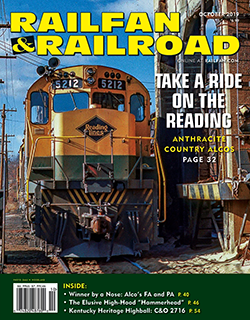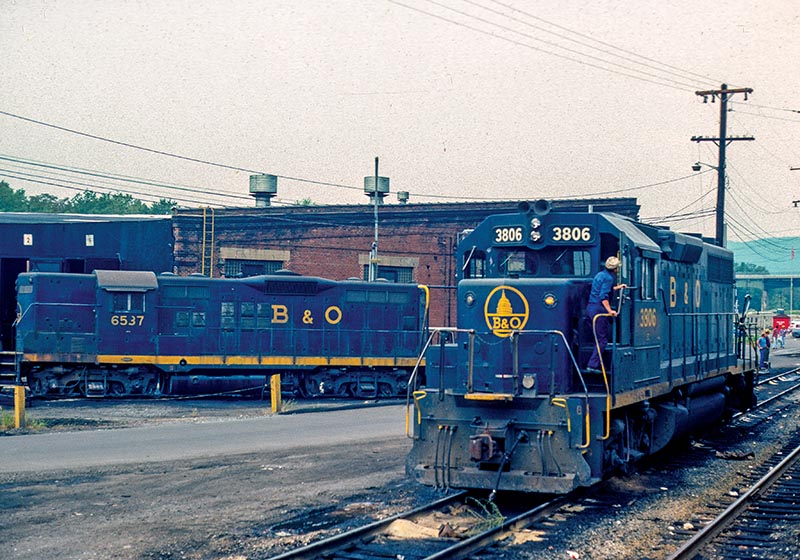 There are a lot of specialty magazines in railroading. One of my favorites is News & Notes, which is put out by the RABO Club, which roughly stands for “Retired Administrators of Baltimore & Ohio Railroad,” its affiliates, and successors. The only reason I get News & Notes is that I’m a reporter who covers railroading. Otherwise, the magazine generally is restricted to people who have retired from B&O, CSX, Chesapeake & Ohio, Seaboard Coast Line and predecessors, Chessie System, and Western Maryland. They must have been non-union officers at least briefly.
There are a lot of specialty magazines in railroading. One of my favorites is News & Notes, which is put out by the RABO Club, which roughly stands for “Retired Administrators of Baltimore & Ohio Railroad,” its affiliates, and successors. The only reason I get News & Notes is that I’m a reporter who covers railroading. Otherwise, the magazine generally is restricted to people who have retired from B&O, CSX, Chesapeake & Ohio, Seaboard Coast Line and predecessors, Chessie System, and Western Maryland. They must have been non-union officers at least briefly.
When the July 2019 issue arrived, I was surprised to see on the front cover an interior photo of a recreation car on Atlantic Coast Line’s Florida Special in the winter of 1962–63. The well-dressed passengers are playing what appears to be board games, supervised by a uniformed train hostess. What jumps out is how much passengers have changed over the years. Every male is wearing a suit and tie, and every woman is dressed fashionably. Today, you won’t find any passenger that well dressed.
News & Notes is filled with excellent and accurate stories with connections to RABO Club railroads. You might think (incorrectly) those railroads would have no connection with the railroads that drove the golden spike at Promontory Summit, Utah, on May 10, 1869. Wrong. Some of the most famous men involved in the building of the first transcontinental railroad were already famous in railroad history or later became so.
Collis P. Huntington was one of the “Big Four” behind Central Pacific Railroad, which also included Leland Stanford, Mark Hopkins, and Charles Crooker. After the Transcontinental Railroad was completed, Huntington was recruited by C&O to help complete the railroad by reaching the Ohio River at Cincinnati from the east. Huntington then turned east and built C&O from Richmond to Newport News, Va., giving C&O an outlet for the coal mines along the railroad in West Virginia and Kentucky. In his honor, the name of Guyandotte, W.Va., was changed to Huntington. I wonder how many of you living in Huntington today even know this.
John Edgar Thomson, before he rose to president of Pennsylvania Railroad, was one of the first stockholders in the new Union Pacific. I would guess that made him rich.
One of my favorite characters, a man with a temper who died too young, was Theodore Judah. He is best remembered as the man who pushed Congress to allocate federal aid for building the Transcontinental Railroad. He also advocated the route over Donner Pass, which was later used. He did not live long enough to see the route completed, as he died of typhoid fever. His connection to CSX came at the beginning of his career; after college, he worked with the survey and construction of Schenectady & Troy, which later became part of New York Central. He then worked for New Haven, Hartford & Springfield, which became part of New York, New Haven & Hartford.
I won’t mention most of the many other people who were named in the article with one exception, someone I had never heard of before, Lewis M. Clement. He was a Canadian who studied engineering at McGill University in Montreal. He came to the U.S. as a shipping clerk for Central Ohio Railroad. He then moved west to St. Louis where he worked for Ohio & Mississippi Railroad. He held various jobs until he moved to Sacramento, Calif., in 1862. He was hired by Theodore Judah to work on surveying a route across the Sierra Nevada range. After Judah died, Clement was named chief assistant engineer of Central Pacific. Later he was named superintendent of track, which put him in charge of the design and construction of the railroad over the Sierra Nevada. His work included the hand-carving of Cape Horn out of the side of a mountain where the railroad is 1,200 feet above the American River.
Clement’s Chinese crews dug 6,213 feet of tunnels including one, Summit Tunnel, which took two years. Clement was an inventor. He created a machine to bend rails to a desired radius and the Emigrant Sleeping Car, which Pullman later improved and called a Colonist Car.
One of my good friends, E. Ray Lichty, is editor emeritus for News & Notes. The July issue contains an article by Lichty about the closing of the 131-year-old Luke paper mill in western Maryland on June 30, which eliminated 675 jobs. Lichty’s article, well-written, goes into great detail about the company and who owned it at various times over the years. At one time, due to the shifting course of a river, the paper mill moved from West Virginia into Maryland. No, the mill didn’t move — the state line moved.
How did Lichty get into the RABO Club? He was a train dispatcher on the Akron Division in the 1950s.
One fascinating story was how sensitive labor negotiations can be, especially when jobs are at stake. When C&O and B&O merged, both labor and management spent months in preparation. It wasn’t just labor; a lot of middle management jobs were going away too. Toledo was one of the most complicated terminals to combine. Neither side could go into negotiations unprepared; almost everyone passed out bogus information, and it was vital for each side to determine what was phony. I learned a lot about labor negotiations and how participants determine who keeps a job.
—DON PHILLIPS is a veteran newspaper reporter and a magazine columnist writing about railroads and transportation policy for more than 40 years.


